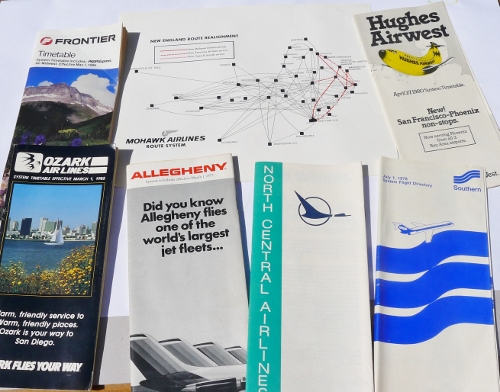The capture of the Mohawk Airlines ad account by AMC's "Mad Men" might have rung a bell with veteran flyers, especially those living in the Northeast U.S. The real Mohawk was based in Utica in upstate New York, and it ran a fleet of 69 passenger jets and some prop planes. Its routes mainly linked small communities across New England to five airports around New York City at JFK, LaGuardia, Newark, White Plains and Islip.
In the TV series, the account went to the fictional Sterling Cooper Draper Pryce ad agency in the mid-60s -- a time when the real Mohawk was being clobbered by air traffic jams in the New York area. Flying into JFK, for example, passengers often found themselves circling nearby Lake Rokonkoma four or five times in the Deer Park Holding Pattern before the plane was cleared for landing. So Mohawk rarely showed up on time.
The airline was dubbed "Slow Hawk" by its passengers, a tag a Mohawk pr man countered with, "That's better than No Hawk."
It was, because if you wanted to fly from regional cities like Utica, Plattsburgh, Watertown, Burlington and Jamestown, you didn't have a choice of carriers. Mohawk was it!

Timetables of some regional airlines, circa 1970s.
Passengers from other small towns elsewhere in the country may recall similar one-airline service at the time. In the Midwest, for instance, Ozark Airlines flew you to St. Louis, where you connected to flights on larger airlines like American and United. And you flew on Southern Airways to Atlanta to hop on the likes of Delta and Eastern.
Likewise, six other regional carriers fed traffic to the big airlines at other connecting terminals: Hughes Airwest at San Francisco, Allegheny at hubs in Pittsburgh and Washington, D.C., Frontier (no relation to the present Frontier) at Denver, North Central at Minneapolis, Texas International at Houston and Piedmont at Charlotte, N.C.
The nine regional airlines shared a common source of financial backing: Uncle Sam, who shelled out subsidies for service to small communities unable to generate enough traffic to make the routes pay for themselves.
Uncle Sam also ruled the roosts of the big carriers. The feds doled out lucrative mainstream routes to the 10 so-called "trunk" airlines of the times, then told them how much they could charge for tickets, much like a regulated utility.
The system fell apart in 1978 when the Airline Deregulation Act became the law of the land. Unchained from Uncle Sam, big and small airlines alike could fly just about anywhere they wanted to and for whatever they wanted to charge.
At that point, as former Frontier CEO Glen Ryland put it, "Even well-run airlines found themselves at the mercy of their weakest, cheapest or dumbest competitor. To stay in the game, they simply had to match the other guy's prices, whether they made money or not."
Only two of the nine regional airlines managed to stay afloat in the choppy waters of deregulation. Among the others, Southern and North Central teamed up to form Republic Airlines (no relation to today's Republic), then added Hughes Airwest to the mix. That deal ended when Republic was sold to Northwest, one of the giant airlines of the day.
Ozark was gobbled up by TWA, which in turn was folded into American. Frontier became a unit of a post-deregulation carrier called PeopleExpress, which in turn became a unit of Continental.
Of the two survivors, Allegheny (which later became USAir and then US Airways) acquired Piedmont and America West, the latter another post-deregulation startup, along with several other smaller carriers.
The other surviving entity was Texas International, the winner of a fierce battle for control of Continental. After that, "TI" as it was called adopted the name of the larger airline, which a few years ago merged with United to become United Continental Holdings, operator of United.
And what about Mohawk? Zapped by the triple whammy of a long, bitter strike, a recession and the shutdowns of General Electric plants in the Northeast -- Mohawk's main source of corporate traffic -- the airline never made it to the deregulation starting line. It was sold to Allegheny in 1972.
Disclosure: The writer was Mohawk's director of public relations for a few years in the late 1960s.
Photo by Bob Schulman
?
"; var coords = [-5, -72]; // display fb-bubble FloatingPrompt.embed(this, html, undefined, 'top', {fp_intersects:1, timeout_remove:2000,ignore_arrow: true, width:236, add_xy:coords, class_name: 'clear-overlay'}); });
Source: http://www.huffingtonpost.com/bob-schulman/mohawk-airlines-slow-hawk_b_1651794.html
new hampshire primary hue jackson alabama football coachella 2012 line up lsu crimson tide crimson tide
No comments:
Post a Comment
Note: Only a member of this blog may post a comment.